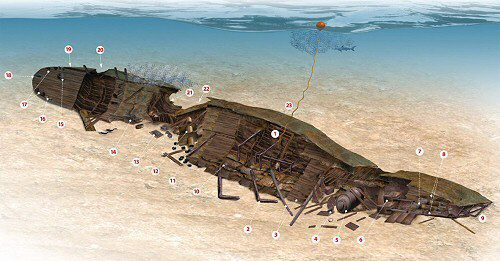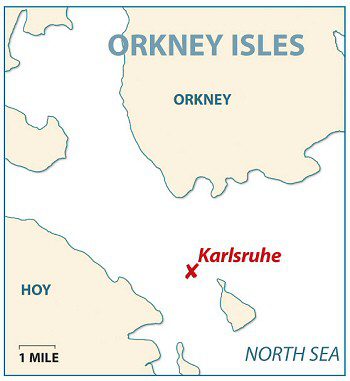Warming up to dive the Scapa Flow wrecks in Orkney? There are few better wrecks for that purpose than this, the shallowest of the WW1 German cruisers, says JOHN LIDDIARD. Illustration by MAX ELLIS
WHEN DECIDING WHICH OF THE SCAPA FLOW wrecks to feature in this year’s Wreck Tours, I had only a small choice left to present – the WW1 Grand Fleet cruiser Karlsruhe, or the WW2 escort boat F2.
In the end, I decided to finish off the set of cruisers, so this month’s tour is the SMS Karlsruhe, at 26m to the seabed a few metres shallower than the other cruisers, a popular warm-up dive and convenient as a second dive after one of the deeper wrecks.
The Karlsruhe is more broken than the other cruisers, but this is one of its charms. Many details hidden deep inside the others are on open view on the Karlsruhe.
As on all the Scapa wrecks, a buoy is permanently attached. On the Karlsruhe it’s attached to the forward of a pair of heavy derricks (1) on the port side, just forward of amidships at a mere 14m. Below this, the corresponding starboard davits have fallen loose to the seabed (2) amid a substantial ladder and a mast at 26m.
The way forward is with the deck at your left shoulder. Masts have also fallen to the seabed, then a large section of teak-planked decking has slipped out slightly as the hull has collapsed (3).
This isn’t that important a part of the wreck in itself, but it marks the point at which to start looking for the helm binnacle (4), a cone-shaped section that is half-buried in the seabed, between the deck section we have just passed and the armoured conning tower (5).
This latter feature is unmissable, a heavy steel cylinder a few metres in diameter and height, with smaller rings on top to protect the captain during battle as he commanded the ship.
Staying on the seabed, our tour is now at the long, tapered bow of the cruiser. Two 5.9in gun turrets (6) have remained loosely connected to their bases, turret shafts and the surrounding deck, while the deck has collapsed. This pair would originally have been side by side, perhaps slightly offset so that they could both fire over the same side of the ship at the same time.
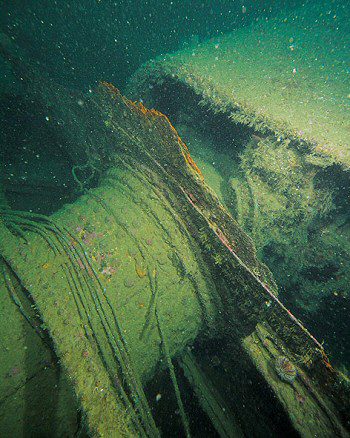
As on the other Scapa Flow cruisers, the backs of the turrets are open, revealing details of the breach and elevation mechanisms of the guns.
The way the deck has folded becomes more apparent a little further forward, where a pair of anchor capstans (7) lie almost one above the other with their own fragments of teak-clad deck, where they would originally have been side by side.
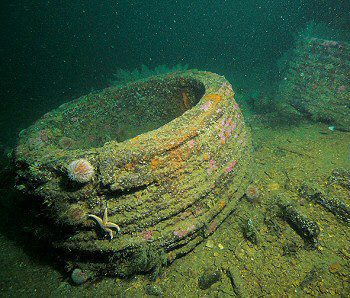
From the capstans, anchor-chain dangles slackly before disappearing down the hawse-pipes, with pairs of big mooring bollards to either side (8).
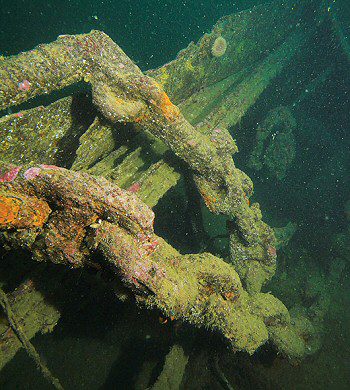
The bow itself is surprising, in that the hull-plates have rotted away to leave just a skeleton of the bow (9), prime real estate for some big plumose anemones where the almost negligible current builds around the end of the wreck.
Now heading aft, back past the boat davits, a plate with an oval hatch (10) marks an area that would have once been unarmoured superstructure, now mostly decayed.
Our route now crosses another big section of teak-planked deck, before arriving at a scattered pile of coal (11).
A look at photographs of the Karlsruhe reveals that there were once more guns in this area, but the most I could find was one of the shafts (12) that would have supported a gun down to the keel of the ship.
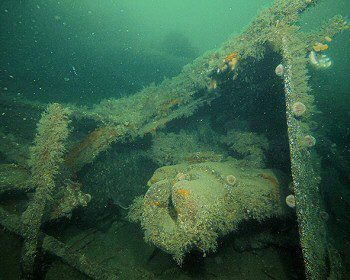
Just below this are some of the features of the Karlsruhe that would have been well inside any of the other wrecks – a kitchen range (13) and a metal storage cupboard.
The wreckage here takes a dip where the hull has been blown open for salvage, but the route aft is easy to follow by continuing along the edge of the wreckage. Now on the stern deck, another gun turret (14) has fallen to the seabed to rest on one side, the gun barrel almost obscured by silt.
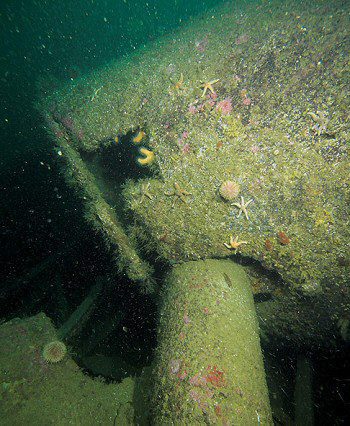
More teak-planked decking leads the way aft to a single capstan for a kedge anchor (15).
To either side of the deck are pairs of bollards (16), then pairs of semi-circular cut-outs (17), each a little less than 1m across. I have yet to identify their purpose – it could be as sophisticated as mine-laying, or as simple as where toilet shacks hung over the stern. I would love to know for sure. There is nothing comparable on the other cruiser wrecks, but the Karlsruhe is a different generation of cruiser.
Right at the stern is a single hawse-pipe for a kedge anchor (18).
Rounding the stern and staying close to the seabed, the rudder has broken loose and rests on the seabed (19). In doing so, it has opened a hole in the hull through which can be seen the top of the rudder-shaft and the huge rams of the steering engine.
Staying on the hull, the starboard propeller-shaft and A-frame (20) lead the way forwards, disappearing only momentarily before we get to the salvage hole. The salvors were after non-ferrous metals, but in the case of the Karlsruhe were not particularly efficient, because several sections of broken turbine ring (21) rest among the debris at the aft end of this hole.
Looking forward, boilers (22) can be seen beneath the hull.
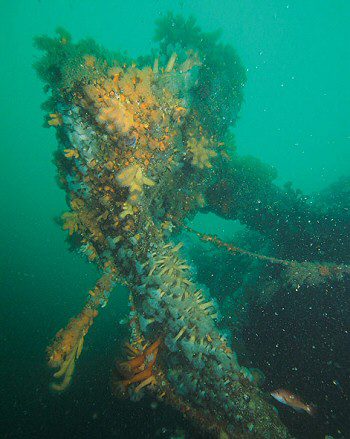
The dive could end here with the launch of a delayed SMB, but the port side of the hull is only 14m deep, and is easy to follow back to the buoyline (23).
With a dive computer that calculates deep stops, a couple of minutes at 14m may actually be compulsory.
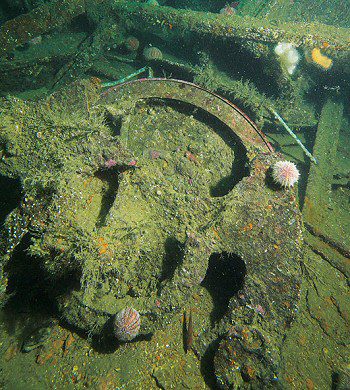
SCUTTLED AT SCAPA
THE KARLSRUHE, light cruiser. BUILT 1916, SUNK 1918
THE KARLSRUHE WAS LAUNCHED at the Kaiserliches yards in Wilhelmshaven on 31 January, 1916.
She was one of three light cruisers to replace losses that the German Navy had suffered in World War One, writes Kendall McDonald.
All three ships were of the Konigsberg II class, but were a vast improvement on the ships they replaced. Karlsruhe joined the High Seas Fleet that November after being fitted out.
Karlsruhe was big – 5354 tons, heavily armoured and with two sets of geared turbines driving two propellers that could give her 28 knots. She was 497ft long with a beam of 47ft and a draught of 21ft.
She was armed with eight 5.9in guns on single mounts on the forecastle and on the quarterdeck, and two 3.5in anti-aircraft guns.
On deck she had two 19.7in torpedo tubes, one either side of the funnel, and two more tube were fitted under water on the platform deck. She could carry and lay 200 mines from ramps on each side of the stern. There were 475 men and 25 officers in the crew.
Karlsruhe’s war service started when she joined the 2nd Scouting Division and was detailed to cover the minesweepers operating in the German Bight.
She joined the German fleet in action against the Baltic Islands to support the 8th Army, which had swept forward to the Gulf of Riga. The Karlsruhe led an invasion of the islands, and landed German troops who destroyed the Russian garrison.
She then went mine-laying in the Baltic, and her last active service was as a guard against any attack by British ships during the evacuation of the U-boat bases at Bruges and Zeebrugge in October, 1918.
Karlsruhe made her final voyage after the Armistice in November, 1918, when she was the lead ship of a line of cruisers surrendering to the ships of the Royal Navy, bringing the total to 74 German warships being interned at Scapa Flow.
On the morning of 21 June, 1919, Karlsruhe’s crew scuttled her, and she sank to the seabed off the island of Cava.
She was one of four cruisers and three battleships that were never raised, though heavy salvage work with explosives was carried out, particularly to midships and forward sections.
TOUR GUIDE
GETTING THERE: Northlink Ferries operates services from Scrabster to Stromness and Aberdeen to Kirkwall, 0845 6000 449.
HOW TO FIND IT: GPS co-ordinates are 58 53.357 N, 003 11.394W (degrees, minutes and decimals) with bow to the north-west. The Karlsruhe is easy enough to find from the co-ordinates with a GPS and echo-sounder, especially as there is a buoy attached at the wreck.
TIDES: The SMS Karlsruhe can be dived at any state of the tide.
DIVING & AIR: Most diving in Scapa is from large hardboats, many with liveaboard “floating bunk-room” accommodation. Boats are generally based in Stromness, but may tie up overnight at other harbours. Air is provided by on-board compressors. Nitrox can be mixed on most boats for an extra charge. Air, weights and cylinders are usually included in the price, so travelling light and using the boat’s equipment is always an option. Scapa Flow Charters operates the boats Jean Elaine and Sharon Rose, 01856 850879.
ACCOMMODATION: Sleep on board, or stay in a hotel or B&B. There is a campsite in Stromness, though camping in this climate is not recommended. Orkney Islands Tourist Board, 01856 872856.
QUALIFICATIONS: An easy dive for a PADI Advanced Open Water or BSAC Sports Diver. Technical diving is not required, but the Karlsruhe is at an ideal depth for extending bottom time with a nitrox mix.
LAUNCHING: If you want to ferry a boat across, there are a number of small slips. The nearest to the Karlsruhe is at Houton. Scapa Flow is a working harbour, so get permission to dive in advance from the harbourmaster.
FURTHER INFORMATION: Admiralty Chart 35, Scapa Flow &Approaches. Ordnance Survey Map 6, Orkney – Mainland, Ordnance Survey Map 7, Orkney – Southern Isles. Dive Scapa Flow, by Rod Macdonald. The Wrecks Of Scapa Flow, by David M Ferguson. The Naval Wrecks Of Scapa Flow, by Peter L Smith. The Wrecks Of Scapa Flow, by Lawson Wood.
PROS: The shallowest of the cruiser wrecks, a popular warm-up or second dive.
CONS: The most broken cruiser wreck.
Thanks to Andy Cuthbertson, Kieran Hatton, Kevin Heath, and various divers from Swansea and Leeds.
Appeared in DIVER March 2009
